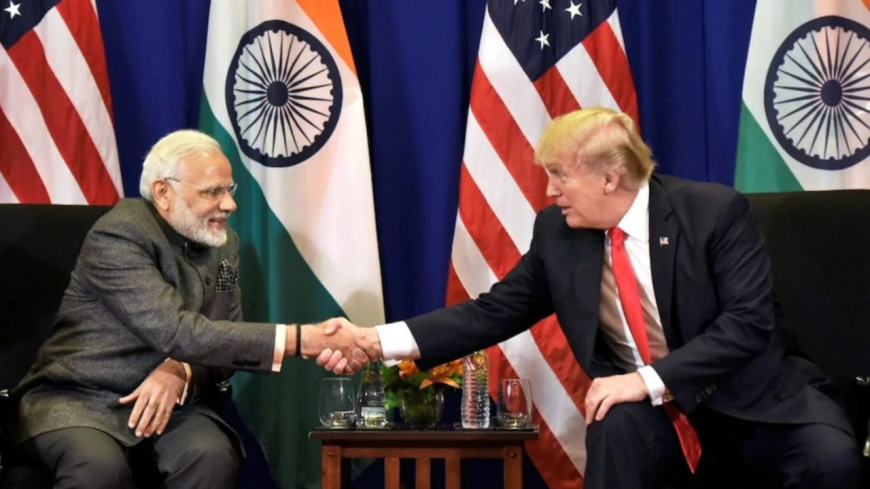India and U.S. Push for Interim Trade Deal: A Strategic Reset Amid Global Economic Shifts
India and the U.S. are in advanced talks to finalize an interim trade deal, aiming to resolve long-standing tariff disputes and strengthen bilateral economic ties ahead of a full free trade agreement.

New Delhi/Washington — Trade Diplomacy Gets a Boost
In a high-stakes effort to recalibrate one of the world’s most consequential economic partnerships, India and the United States are closing in on a long-anticipated interim trade deal, which could be finalized as early as this week. The deal is expected to ease long-standing tariff irritants, remove non-tariff barriers, and lay the foundation for a broader Free Trade Agreement (FTA) in the future.
This development comes amid growing global uncertainty, supply chain realignments, and mutual strategic needs. According to a report by the Financial Times, senior trade negotiators from both countries are currently reviewing the final contours of the agreement, which would unlock trade flows worth billions of dollars annually.
What’s at Stake in This Interim Deal?
The India–U.S. bilateral trade relationship, valued at over $200 billion in 2023, has witnessed both growth and friction in recent years. The interim deal is expected to address key sticking points:
1. Tariffs on Agricultural Goods
The U.S. has long pressed India to open up its market to American agricultural exports such as almonds, cherries, and pork. In return, New Delhi is seeking tariff reductions on Indian basmati rice, mangoes, and shrimp.
2. Digital Services & E-Commerce
India’s evolving data protection laws and restrictions on cross-border data flow have been points of contention with American tech giants. The interim deal may include frameworks for digital trade and data localization norms.
3. Pharmaceuticals & Medical Equipment
Indian generic drug manufacturers are lobbying for expedited FDA approvals and recognition of Indian pharmaceutical standards, while U.S. firms are pushing for relaxed price caps on medical devices in India.
4. Restoration of GSP Benefits
India lost its status under the Generalized System of Preferences (GSP) in 2019. Restoration of these preferential tariffs could help Indian exporters of textiles, leather, and gems regain competitiveness in the U.S. market.
Strategic Context: More Than Just Trade
This isn’t just about economics. The interim deal also reinforces India and America’s evolving strategic partnership—especially in the context of:
-
Countering China’s dominance in global supply chains
-
Advancing the Indo-Pacific Economic Framework (IPEF)
-
Enhancing tech and defense cooperation between the two democracies
“Trade is the bedrock of any strategic partnership. Finalizing this interim deal is a logical next step after the momentum we’ve built in defense and technology,” said a senior U.S. trade official quoted by Reuters.
Industry Reactions: Optimism Mixed With Caution
Indian exporters and industry bodies are viewing the deal with cautious optimism. The Federation of Indian Export Organisations (FIEO) has called the talks “encouraging,” while also flagging concerns over agricultural market access and data policies.
“This deal, if balanced and fair, could act as a major booster shot for Indian MSMEs and exporters looking to deepen their reach in the American market,” said FIEO President A. Sakthivel.
On the U.S. side, the U.S.-India Business Council (USIBC) and leading multinationals like Amazon, Boeing, and Pfizer have lobbied for faster resolution of regulatory hurdles and more clarity on India’s taxation policies.
For more insights, read USIBC’s recent policy brief on U.S.–India trade alignment.
Challenges That Remain
Despite progress, significant challenges remain:
-
Agricultural sensitivities: India is unlikely to concede on certain staple crops, which are politically volatile ahead of its 2026 state elections.
-
IPR (Intellectual Property Rights): Washington’s demands for stronger patent enforcement could run into opposition from India’s generic drug sector.
-
Digital sovereignty: India’s upcoming Digital India Act may clash with U.S. expectations on cross-border data flows.
Without a broader framework, this interim deal may be seen as a stop-gap, rather than a long-term solution.
Political Implications
On both sides, this agreement carries political weight. For the Modi government, which is pushing “Viksit Bharat 2047” (Developed India roadmap), this trade progress adds international credibility. For the Biden administration, eager to strengthen economic alliances without triggering domestic backlash, this deal is a manageable win ahead of the 2026 midterms.
Interestingly, this trade deal is also being seen as a counter-narrative to protectionist sentiments globally.
Looking Ahead: Toward a Comprehensive FTA?
While both governments are currently downplaying the talk of a full-fledged FTA, experts believe that the interim deal could serve as a building block.
“This deal could be the digital handshake needed to unlock full-spectrum trade liberalization in the coming years,” said Nisha Biswal, former U.S. Assistant Secretary of State and current head of the U.S.–India Strategic Partnership Forum (USISPF).
Negotiators are reportedly considering quarterly review mechanisms to ensure accountability and progress toward broader trade integration.
Final Word
The India–U.S. interim trade deal, if finalized this week, could usher in a new era of pragmatic trade diplomacy between the world’s largest democracies. While it won’t resolve all disputes, it does signal a mature willingness to cooperate where possible and negotiate where necessary.
As global supply chains shift and economic blocs re-align, this agreement could well become a case study in how geopolitical and commercial interests can co-exist—and even thrive—when guided by shared democratic values.














